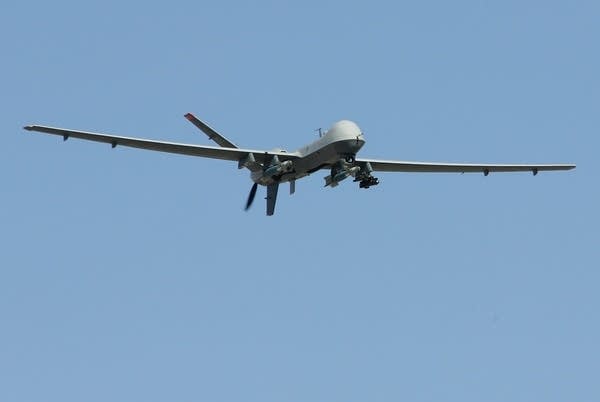Minnesota seeks selection as a drone test site
Go Deeper.
Create an account or log in to save stories.
Like this?
Thanks for liking this story! We have added it to a list of your favorite stories.

Minnesota is one of 37 states in the running to be named an FAA test site for drones.
More from the Associated Press:
The Federal Aviation Administration last month put out a call to test-fly drones at half a dozen to-be-determined sites before they can share the same space as commercial jetliners, small aircraft and helicopters.
Fifty teams from 37 states answered, vying to win bragging rights as a hub for unmanned aerial vehicles.
Turn Up Your Support
MPR News helps you turn down the noise and build shared understanding. Turn up your support for this public resource and keep trusted journalism accessible to all.
The military has long flown drones overseas to support troops, spy on enemies and fire missiles. There's a recent clamor to fly them domestically to track the health of crops, fight wildfires in remote terrain, conduct search and rescue after a disaster and perform other chores considered too "dirty, dull or dangerous" for pilots. The expanding use of drones has prompted fears that America might become a "Big Brother" society.
The untapped civilian market — estimated to be worth billions — has created a competition among states that want the business. They tout such assets as ample restricted airspace, industry connections and academic partners.
"It's the chance to get in on the ground floor of what may be the next big business," said Peter Singer, a robotics expert at the Brookings Institution, a think tank in Washington. "The states competing hope it might make them the robotics equivalent of Detroit for automobiles in the 20th century or Silicon Valley for computers."
Winners will play key roles in helping the government seamlessly transition drones, which are controlled remotely by joystick, into the civilian airspace without crashing into other planes or injuring bystanders.
Supporters of a Southern California test site point to an existing drone presence there. General Atomics Aeronautical Systems Inc., based in the San Diego suburbs, makes the Predator that has seen use in Iraq and Afghanistan. Just outside of downtown Los Angeles, AeroVironment introduced the world's first hummingbird spy plane and is developing other tiny drones inspired by biology.
"From start to finish, you can do your UAV work here," said John Rose of the American Institute of Aeronautics and Astronautics, which cosponsored a three-day drone conference in the Los Angeles area focused on civilian uses.
There are two competing California bids from airport agencies in Ventura County northwest of Los Angeles and Kern County in the Mojave Desert.
"If we are successful, it would be an economic stimulus for the region moving forward," said Bill Buratto of the Ventura County Economic Development Association, which is working with county airport officials on a plan to have drones fly from Point Mugu, the site of numerous Navy training exercises.
Their in-state competitor envisions test flights out of the high desert skies about 150 miles north of Los Angeles and touts its remoteness and access to military and civilian facilities currently doing drone research.
"You kind of want to be in the middle of nowhere. You don't want to risk being close to a populated area," said Eileen Shibley, who leads the effort for the Indian Wells Valley Airport District.
Other states have taken a different tack, putting on a united front or partnering with a neighboring state to pool resources.
Ohio — the home state of Apollo 11 astronaut Neil Armstrong, Mercury astronaut John Glenn and the Wright brothers — teamed with Indiana to increase both states' odds. Like California, there is budding drone activity in Ohio, most notably the Air Force's sensor research at Wright-Patterson Air Force Base.
Joseph Zeis of the Dayton Development Coalition doesn't see this as a competition.
"When the test-site selection is over, we're all collaborating on a single goal" to safely merge drones into the national airspace, said Zeis, who's spearheading the Ohio-Indiana venture.
The FAA is expected to choose the six drone test sites by year's end.
The specter of thousands of unmanned eyes swarming the sky in the coming years has unnerved privacy advocates, who fear ordinary Americans would be overzealously monitored by law enforcement, considered likely to be among the top users of the technology in the future. As part of the selection process, test site hopefuls must publish a privacy policy and follow existing privacy laws.
The Association for Unmanned Vehicle Systems International does not have a favorite. But the voice for the domestic drone industry acknowledged that states hosting test sites would benefit economically.
In a report published earlier this month, the group said states with an already solid aerospace industry are predicted to gain drone business. But other factors, including location of test sites, will also drive job creation.
That's why California needs to act fast, said state Assemblyman Jeff Gorell, who has been pushing for a test site in his district.
"This is a great opportunity for California," he said. "We might be able to recapture some of the golden era of aerospace."



